Our Favorite Trail Running Shoes
Check out our Best Trail Running Shoes article to learn about our current favorite trail running shoes!
New Balance Vazee Summit Review
New Balance released the Vazee Summit, a highly anticipated update to the MT110 series, to little fanfare this March, and for most trail and ultra runners it went completely unnoticed. What may have started as an update has now morphed into a completely new design for New Balance. The Vazee Summit was built as a great lightweight all arounder, capable of short and fast races on technical trails as well as ultra distance romps through varying terrain. Well, how did New Balance do? After a disappointing update in the MT110v2, it feels like New Balance threw the blueprint out the door and started with one of their most beloved road racing flats, the RC1400.
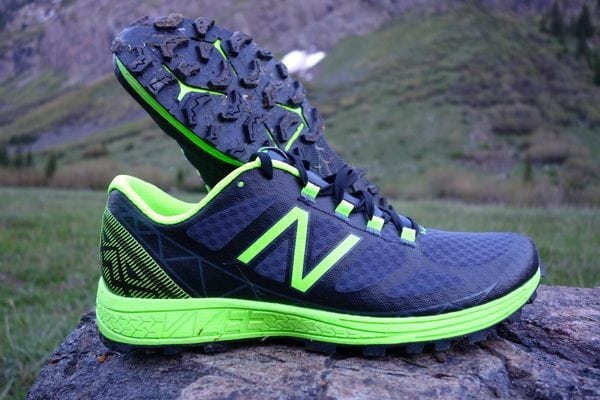
The New Balance Vazee Summit.
You may be questioning why any running shoe company would fashion their trail running shoes on a racing flat last. But, lets look around at what people are wearing on the trails. Jim Walmsley, winner of seemingly everything he’s entered in the last year as well as the 2016 Lake Sonoma 50 Mile, is regularly seen sporting Adidas Adios Boost 2s. Additionally, Tim Freriks finished second at Sonoma in the same shoe. David Roche battled the sloppy mud at Way Too Cool 50k this spring in Nike Lunaracers. The concept is simple; racing flats provide a lighweight, foot-hugging feel that provide just enough protection for most non-technical courses.
However, New Balance took this concept and added enough protection for any trail running surface while still keeping the fit and ride of RC1400. So, I will aim at detailing what I like about the Vazee Summit which, in my opinion, is finally New Balance’s redemption for the discontinued and much beloved MT110 (while being totally different).
Upper
When I first tried on the Vazee Summit I was unimpressed. The look and last of the shoe appeared narrow, and having never worn the RC1400, I was expecting a fit that was a bit snug for my liking. How incredibly wrong I was, and within several weeks the Vazee Summit went from being shelved after a disappointing 5-mile trail run to staying on my feet exclusively for nearly three weeks. Gradually, the open mesh upper conformed to my wide forefoot creating a great locked-down feeling that was perfect for steep downhills. New Balance also uses a gusseted tongue which is a bit remeniscint of Salomon’s Endofit system which provides a soft foot-hugging feel. This tongue, which is very stretchy, seems to decrease the need to tie the shoes tightly which would put pressure on the top of the foot, and New Balance uses simple flat laces that stay tied well.
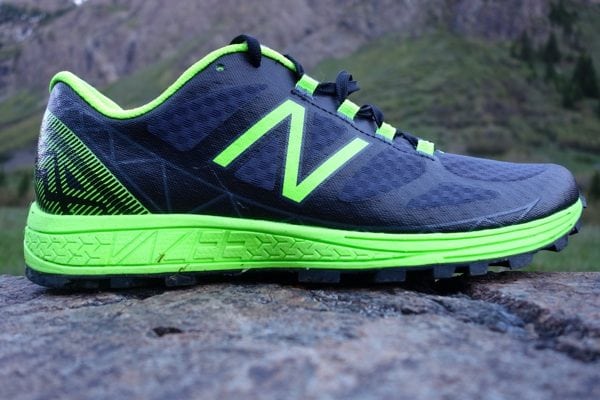
The New Balance Vazee Summit’s lateral upper.
The entire upper is seamless and there are ample welded on overlays, especially around the rand of the shoe, which keep the upper from feeling flimsy. In fact, I was pleasantly surprised just how well the mesh kept dirt and dust from getting into the interior of the shoe while simultaneously draining quite well when wet. New Balance also incorporates what they call Internal Toe Protect which is a bit of a misnomer. Rather than placing a rubberized toe cap on the shoe, they simply beef up the welded overlays creating a more durable toe box that offers some protection and maintains its shape. Again, this is something we’ve seen in the Salomon S-Lab series shoes for the last several years.
Midsole
Initially, some reported that the Vazee Summit had an Acteva Lite midsole, a very firm but durable foam used for the original and reissue of the MT101. I was pleased to see that New Balance, in fact, used its more forgiving Revlite foam of which I am a huge fan. It seems to maintain its resiliency well and seems to provide me with enough cushioning, especially in the forefoot area where I seem to have problems during longer runs. Its an odd sensation, because initially the Vazee Sumit felt firm and unresponsive, but after several longer runs I almost felt like the shoe was getting more comfortable and cushioned, and I never felt sore on my forefoot the next day. It helps that New Balance employs a 3/4 rock plate that retains its flexibility underneath a nicely lugged outsole.
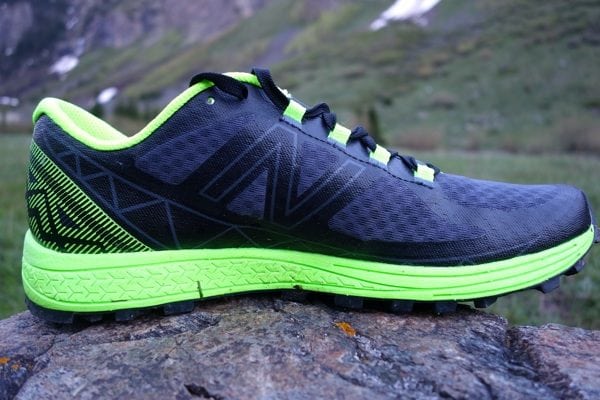
The New Balance Vazee Summit’s medial upper.
A 10mm drop in the outsole initially warranted reservation, but this shoe really runs like a 6mm drop. I have no idea or hypothesis as to why that is, but I never feel like my heel is elevated or at risk of rolling an ankle. It also doesn’t feel like any transition for me to wear a 4mm drop shoe one day and, then, transition into the Vazee Summit the next.
Outsole
New Balance uses a rubber technology developed almost a decade ago for their water shoes for increased traction in wet conditions on the Vazee Summit. Now, this Hydro-hesion rubber has been redeveloped for increased durability, and the updated version works well on all surfaces and also seems highly durable. After about 120 trail miles on my Vazee Summits the outsole lugs show no wear whatsoever. The basic outsole lug pattern is very effective and the 4.5mm lugs dig into just about any surface, and they’re large enough to shed mud as effectively as anything other lug pattern on the market.
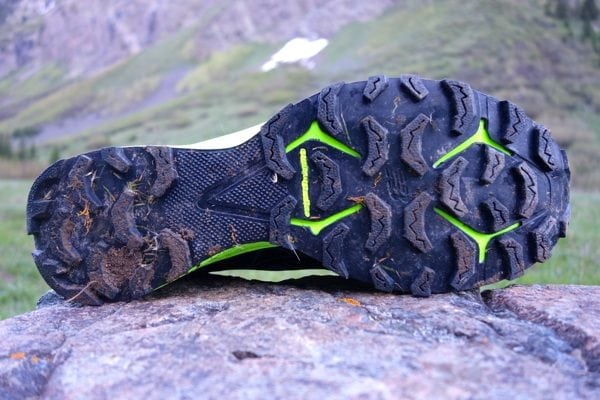
The New Balance Vazee Summit’s outsole.
Overall Impressions
Bryon Powell ran the entire 2015 Hardrock 100 in a pair of New Balance RC1400v3s. Again, that’s 100 miles on some of the most technical terrain in the United States, in a pair of 6.5-ounce racing flats without any lugs. What I took away from his experience is that you have to run and race in what feels good on your feet. I think that we all long for a shoe that will alleviate the bone shattered tenderness that is the result of a well run ultra, but your feet are going to be in rough shape after 100 miles regardless. I start every season obsessing about forefoot cushioning, toe box room, and just about every other aspect of shoe construction. However, I end each ultra season running in what feels good on my feet, and the New Balance Vazee Summit fits my feet exceptionally well. This is a very simple, and well made trail shoe, and the Revlite midsole and rockplate give me enough protection to enjoy twenty miles on the trails without having to think about anything else other than being in the mountains. At about 9.3 oz for my size 10 US, the Vazee Summit is a great all around trail shoe that I encourage every runner to try on. It handles fast paces just as well as easy slogs, and the ride and transition is just as smooth on the road as it is on technical trails.
My question going forward is whether or not the Vazee Summit can handle 50-100 mile distances? I aim to answer that question at this year’s San Juan Solstice, but in the meantime I’d love to hear your feedback and what your experiences are in this shoe.
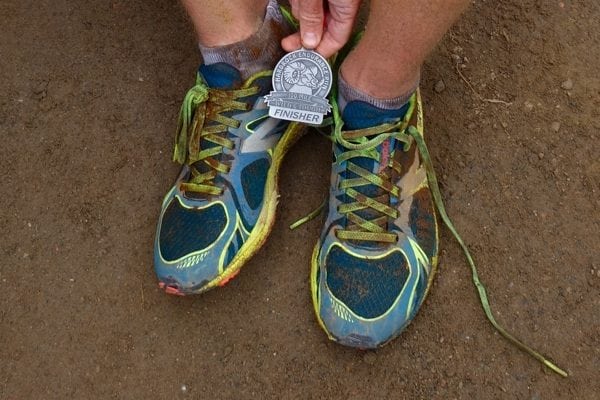
Bryon’s New Balance 1400v3 upon completing Hardrock ’15.
[Editor’s Note: If you’re leaving a comment regarding a product made by a company with which you’re affiliated (employee, ambassador, etc.), please share your relation in each of your comments on this article. Thanks!]
